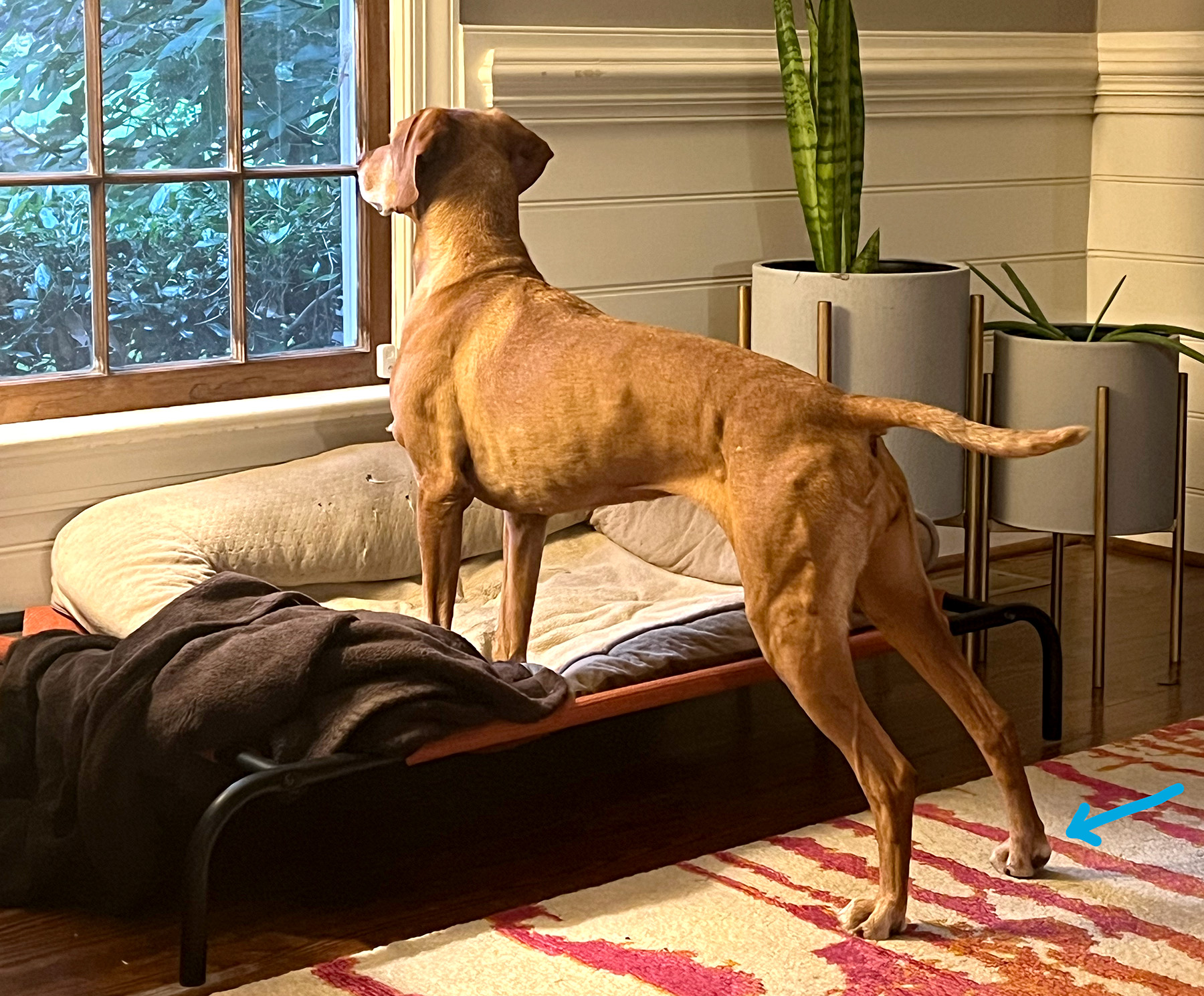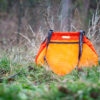This summer, Zara got injured.
On June 20th, I noticed she was limping on her right rear leg when she got up from sleeping or laying down. Being cautious, I started her on leash restriction right away – no free time in the yard and leashed walks only. When she was still limping a week later even after keeping her leashed, I was worried, so I took her to the vet.
They did an exam and X-rays, and because of some swelling around the knee joint, diagnosed her with a partial cranial cruciate ligament (CCL) tear. Needless to say, this was not what I was hoping to hear. A quick Google search made me realize that a partial CCL tear is a major injury because most partial tears will fully tear eventually. Ligaments don’t usually heal on their own – they often require surgery.
Needless to say, I was freaking out. We had just spent the past month and a half training for the NAVHDA Invitational and things were going well. The test was still a few months away in September, but a CCL tear was going to throw a major wrench into things. I didn’t know if she’d be able to compete. She was 9.5 – was this the end of her competition career? The more I read about tears and surgery, the more depressed I got.
Our primary vet recommended going to see an orthopedic surgeon to get another opinion and starting physical therapy. The vet didn’t seem super concerned. I imagine that many 9.5 year old dogs with a partial CCL tear aren’t super active and some could avoid having surgery just by being conservative with activity the rest of their lives. That was not going to be the case for Zara. She was not a dog that would be content to lay around on the couch and go for leash walks. I knew I was going to do everything I could to get her back to full functioning.
Developing a Plan
In the meantime, I was careful. I kept Zara on the leash, even out in the yard. I suspected that she may have injured herself by chasing a rabbit in the yard, so anytime she wanted to go outside, I would walk around the yard with her on a leash. We had to stop most of our training, but I still worked on heeling.
I tried to eliminate jumping as much as possible. I put makeshift steps next to the couch so that she wasn’t jumping on and off as much. Normally, she sleeps in our bed at night but jumps off and on throughout the night to alternate between our bed and her dog bed. Our bed is pretty high off the floor so I didn’t feel comfortable with her doing that. I decided to crate her at night – something we hadn’t done regularly since she was about 18 months old. Thankfully, she adjusted quickly.
As part of the healing process, our vet recommended using a cold laser device on her leg to promote healing. We were able to rent a device through the vet’s office, which was great because then I could do laser treatments twice a day, every day. I continued that for about 2 months. Best of all, our Nationwide pet insurance covered for the cost.

Zara poses with the laser device.
Visiting Specialists
About two weeks after the initial diagnosis, we saw an orthopedic surgeon. He examined Zara and couldn’t find any instability in her knee. By this point, she’d stopped limping. He said it was possible she had a knee sprain instead of a tear and time would really tell as to which one it was.
I also got the contact information for Dr. Robert Gillette, a veterinary specialist based in South Carolina who has a lot of experience with working and military dogs. Two of my field trial friends had gone to see him when their vizslas had injuries and had good things to say about him. I felt like he would be able to give me a good idea of whether the Invitational was still a possibility.
Zara and I drove to Lancaster, SC on July 11th. Dr. Gillette did a very comprehensive analysis of Zara. The visit lasted about 3 hours! He got her history, did a manual exam, photographed her with a thermal camera, had her walk on a pressure mat, and took blood to test for tickborne diseases (some of those can cause limping). I was impressed with how thorough he was.
He pinpointed her issue as a digital flexor muscle strain in her right rear leg. She also had a minor carpal sprain in her front wrist. Since the strain is a muscle-based injury, not something involving a ligament, he was confident that she would make a full recovery. Needless to say, that was a relief to hear. He recommended keeping her on leash for another 5 days, giving her some pain medicine and muscle relaxants, and then gradually introducing activity after that. He wanted us to continue the laser therapy as well.

An image of Zara taken by a thermal camera at Dr. Gillette’s office.
Consulting With a Canine Rehab Specialist
Shortly after visiting Dr. Gillette, I also consulted with Dr. Sophia Fuller at On Point Animal Rehabilitation Therapy. She has a vizsla and I had met her at a field trial the previous spring. She did two virtual video consults with me and we discussed exercises I could do with Zara to help strengthen her core and leg muscles. She recommended doing these exercises three times a week. We also talked about a warmup and cooldown routine for any time I was training/running Zara in competitions. I found this super helpful. One thing she told me to look for was “weight-shifting.” This would be where Zara was putting less pressure on the injured leg when standing. I noticed that she did this for about two months after initially being injured.

Zara weight shifting on her back legs. See the blue arrow? More of her weight is on her left rear leg instead of evenly balanced between the two.
This sit/stand exercise is part of Zara’s rehab routine.
Diet
During this time, I continued Zara’s regular raw diet. However, I also made sure to include golden paste, which is supposed to help reduce inflammation. I also gave her homemade bone broth. It’s hard to say if those things really did much, but I figured they couldn’t hurt!
I kept Zara on leash for a total of four weeks. After that, I gradually started letting her run, swim, and train again, at least outside of our property. Because there were so many rabbits in our yard, and I suspected that chasing a rabbit was the source of her injury, I walked her on-leash in the yard for the rest of the summer (12 weeks), until we went to the Invitational. Needless to say, that was not fun for either of us, but the test was too important to me to risk her re-injuring her leg. Once we got back, I let her be free in the yard again.
As many of you probably know, we were able to go to the Invitational in September and we passed. :) Since this, she’s been competing in field trials and doing fine. I still try to do the rehab exercises at least once and week and warm her up before she runs. I’m careful about not letting her jump off of things and I don’t like to throw toys anymore because of the way she hurtles after them without any regard for her limbs. I feel like I’m a bit paranoid now, but I’d like to keep her healthy for as long as possible. I’m grateful that she didn’t have a more serious injury (like a CCL tear) and I was able to connect with specialists who could help us. It definitely pays to get a second opinion if your dog has a injury.






